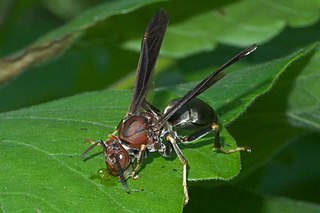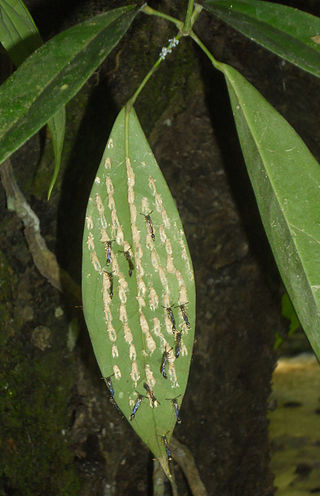
The European paper wasp is one of the most common and well-known species of social wasps in the genus Polistes. Its diet is more diverse than those of most Polistes species—many genera of insects versus mainly caterpillars in other Polistes—giving it superior survivability compared to other wasp species during a shortage of resources.

Polistes gallicus is a species of paper wasp found in various parts of Europe, excluding England, Denmark, and Scandinavia, from warmer climates to cooler regions north of the Alps. Nests of these social insects are created in these various conditions. The Polistes species use an oral secretion to construct their nests, which consist of a combination of saliva and chewed plant fibers. This structural mixture physically protects the nest from various harsh elements and from weathering over time.

The Stenogastrinae are a subfamily of social wasps included in the family Vespidae. They are sometimes called hover wasps owing to the particular hovering flight of some species. Their morphology and biology present interesting peculiarities.

Ropalidia marginata is an Old World species of paper wasp. It is primitively eusocial, not showing the same bias in brood care seen in other social insects with greater asymmetry in relatedness. The species employs a variety of colony founding strategies, sometimes with single founders and sometimes in groups of variable number. The queen does not use physical dominance to control workers; there is evidence of pheromones being used to suppress other female workers from overtaking queenship.

Polistes chinensis is a polistine vespid wasp in the cosmopolitan genus Polistes, and is commonly known as the Asian, Chinese or Japanese paper wasp. It is found in East Asia, in particular China and Japan. The subspecies P. chinensis antennalis is an invasive species in New Zealand, having arrived in 1979.

Polistes metricus is a wasp native to North America. In the United States, it ranges throughout the southern Midwest, the South, and as far northeast as New York, but has recently been spotted in southwest Ontario. A single female specimen has also been reported from Dryden, Maine. Polistes metricus is dark colored, with yellow tarsi and black tibia. Nests of Polistes metricus can be found attached to the sides of buildings, trees, and shrubbery.

Polistes fuscatus, whose common name is the dark or northern paper wasp, is widely found in eastern North America, from southern Canada through the southern United States. It often nests around human development. However, it greatly prefers areas in which wood is readily available for use as nest material, therefore they are also found near and in woodlands and savannas. P. fuscatus is a social wasp that is part of a complex society based around a single dominant foundress along with other cofoundresses and a dominance hierarchy.

Polistes carolina is one of two species of red paper wasp found in the eastern United States and is noted for the finer ridges on its propodeum. It is a social wasp in the family Vespidae and subfamily Polistinae. The species is native to the United States from Texas to Florida, north to New York, and west to Nebraska. The wasp's common name is due to the reddish-brown color of its head and body. P. carolina prefer to build their nests in protected spaces.
Belonogaster juncea juncea is a subspecies of Belonogaster juncea and is classified as a primitively eusocial wasp, meaning that the species is social while exhibiting a morphology that is indistinguishable from that of other castes. It is also classified as a type of African Paper Wasp. Many of the studies relating specifically to B. j. juncea take place at the University of Yaoundé in Cameroon.

Polistes nimpha is a eusocial paper wasp found all over Europe, with particular sightings in Turkey, Finland, Estonia, and Latvia. It is also found in northern Africa, Pakistan, Iran, India, Kazakhstan, Mongolia, and China. The climate in these areas is relatively cold and snowy in the winter, while summers are usually hot and dry, with steppe vegetation. Polistes nimpha colonies are relatively small and easily manipulated.

Polistes bellicosus is a social paper wasp from the order Hymenoptera typically found within Texas, namely the Houston area. Like other paper wasps, Polistes bellicosus build nests by manipulating exposed fibers into paper to create cells. P. bellicosus often rebuild their nests at least once per colony season due to predation.

Liostenogaster flavolineata is an insect that belongs to the wasp family Vespidae. This hairy-faced hover wasp species is predominantly found in South Asian rain forests, especially in Malaysia. Individual colonies of this species are very small, but aggregations of nests allow for interactions between many smaller colonies. Some worker wasps, known as "helpers", will move between multiple nests in an attempt to improve their position in the dominance hierarchy. Its nests are pale-colored and are usually built with mud. Liostenogaster flavolineata is one of the most studied species in the Stenogastrinae.

Parischnogaster mellyi is a medium-sized species of a hover wasp in the family Vespidae. It is found in Southeast Asia and is widely spread in Thailand and Malaysia. Its nests feature flexible and dynamic qualities, and they are commonly seen under roofs of houses and huts in rural areas. Hovering and patrolling behaviors are the species’ main defining behavioral features, and such activities are closely linked to its mating patterns.

Belonogaster petiolata is a species of primitively eusocial wasp that dwells in southern Africa, in temperate or subhumid climate zones. This wasp species has a strong presence in South Africa and has also been seen in northern Johannesburg. Many colonies can be found in caves. The Sterkfontein Caves in South Africa, for example, contain large populations of B. petiolata.

Polistes biglumis is a species of social wasp within Polistes, the most common genus of paper wasp. It is distinguished mainly by its tendency to reside in montane climates in meadows or alpine areas. Selection pressure from the wasp's environment has led to several idiosyncrasies of its behavior and lifecycle with respect to its relative species in the genus Polistes. It alone among paper wasps is often polyandrous. In addition, it has a truncated nesting season that gives rise to unique competitive dynamics among females of the species. P. biglumis wasps use an odor-based recognition system that is the basis for all wasp-to-wasp interaction of the species. The wasp's lifecycle is highly intertwined with that of Polistes atrimandibularis, an obligate social parasite wasp that frequently invades the combs of P. biglumis wasps.

Polistes semenowi is a species of paper wasp in the genus Polistes that is found in southeastern and southern central Europe, as well as central Asia, and was until 2017 erroneously known by the name Polistes sulcifer, while a different species was incorrectly believed to represent P. semenowi. It is one of only four known Polistes obligate social parasites, sometimes referred to as "cuckoo paper wasps", and its host is the congeneric species Polistes dominula. As an obligate social parasite, this species has lost the ability to build nests, and relies on the host workers to raise its brood. P. semenowi females use brute force, followed by chemical mimicry in order to successfully usurp a host nest and take over as the queen.
Parischnogaster nigricans serrei is a hover wasp subspecies in the family Vespidae, and it is predominantly found in the Java region of Indonesia. Its nest cells are of conical structure, linearly attached to a string-like substratum. The nests are typically found in places open to human interactions, such as gardens, trees, or forests around villages. There is a clear dominance hierarchy within colonies, which often affects the behavioral activities of its members. The wasp’s most common predators are Vespa tropica, also known as the great banded hornet. P. nigricans serrei defends itself by flying away or giving out alarm calls.

Parischnogaster striatula is a species of social hover wasps found in Southeast Asia. Their nests are uniquely shaped, mimic their surroundings and, like the other Stenogastrinae social wasps, lack a nest pedicel. They are also unique in their use of glandular secretion when laying eggs. P. striatula is also different than typical wasps because the queens are not the only ones who possess reproductive capabilities; other females also have developed ovaries. This wasp is also known for fiercely protecting its nest against enemies, such as ants or other hornets.

Parischnogaster jacobsoni is a species of social wasp within Parischnogaster, the largest and least known genus of Stenogastrinae. It is distinguished mainly by its tendency to construct ant guards on its nests. Natural selection has led this wasp to have a thick substance emitted from its abdominal glands that allows it to protect its nest from invasions. Parischnogaster as a genus has been relatively unstudied; P. jacobsoni is one of the few investigated species because it has sufficient durability to live near human populations and it has demonstrated unusual resilience to pollution. While P. jacobsoni is a more complex organism than other wasps in Parischnogaster, the genus overall is relatively primitive with respect to social wasps as a whole.

Parischnogaster is a genus of hover wasps from the subfamily Stenogastrinae, a subfamily of eusocial wasps endemic to the Oriental Region which are included in the family Vespidae.


















